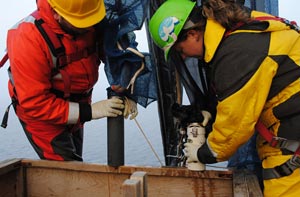Please note: You are viewing
the unstyled version of this website. Either your browser does not support CSS
(cascading style sheets) or it has been disabled. Skip
navigation.
Dr. Mary-Louise TimmermansAugust 12, 2011After CTD/Rosette and zooplankton net casts in the morning, we spent much of the day steaming to our next science station at 73.5N, 138W. Progress was slow at times due to dense fog and regions of concentrated thick ice; these conditions require considerable concentration by the Captain and the officers on the bridge using the ship’s X-band radar to identify leads, or pathways of open water within the ice pack. On our transit, it was necessary to cross numerous pressure ridges (formed as a result of pressure exerted on the ice by the winds) of seasonal and multi-year ice, which made for a bumpy ride. The day of steaming provided the WHOI mooring team a chance to download data after the recovery of Mooring D and prepare instruments and gear for the re-deployment tomorrow. Those working in the lab were able to catch up on their analyses and begin data reports. Many people spent time on deck today enjoying relatively mild temperatures and the striking variety of sea ice. Chief Scientist Bill Williams spotted polar bear tracks on a floe over the side of the ship, while others saw seal breathing holes. Since the beginning of the cruise, we’ve seen bowhead whales, one polar bear (swimming), seals, Arctic tern, Arctic cod, and a thick-billed Murre. Last updated: October 7, 2019 | |||||||||||||||||
Copyright ©2007 Woods Hole Oceanographic Institution, All Rights Reserved, Privacy Policy. | |||||||||||||||||



